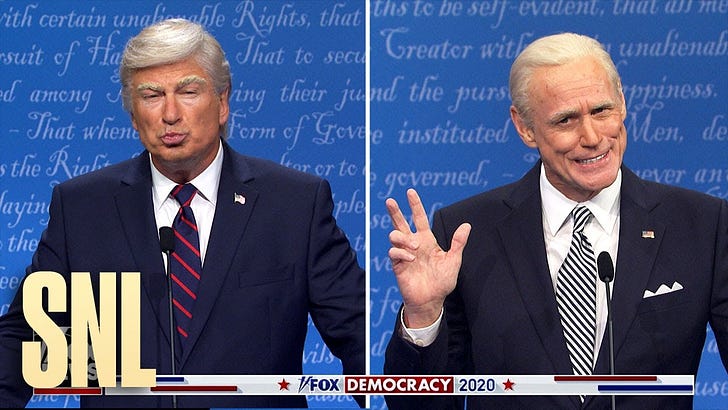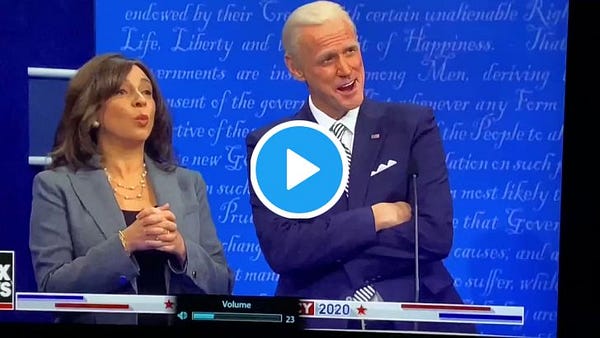If you can, please support independent comedy journalism by upgrading your subscription:
Over the weekend Saturday Night Live returned with a live studio audience. “We need the audience,” creator Lorne Michaels said in a preseason interview with Vulture. “With comedy, when you don’t hear the response, it’s just different.” He said SNL was working with Governor Andrew Cuomo’s office to ensure its audience and employees would be as safe as possible. In a curious twist, the Cuomo Administration suggested a week before the premiere that it wasn’t satisfied with the show’s safety protocols. A Health Department spokesperson told USA Today that SNL wasn’t complying with the state’s guidance on media production, which prohibits shows from hosting live audiences unless they consist entirely of people employed by the show:
Responsible Parties must prohibit live audiences unless they consist only of paid employees, cast, and crew. Employees, cast and crew may make up a live audience of no more than 100 individuals, or 25% the audience capacity, whichever is lower. Live audiences must maintain social distance of at least six feet in all directions.
As the New York Times reported yesterday, SNL dealt with the Health Department’s concern by paying audience members $150 apiece. This seems to be enough for the authorities, which told the Times that SNL “confirmed to them that it had followed the state’s reopening guidance by selecting audience members through a third-party screening and casting process and by compensating them for their time.” Jonah Bruno, a spokesperson for the Health Department, added: “There is no evidence of non-compliance—but if any is discovered, we will refer that to local authorities for follow up.”
But what about the other part of that rule? “Live audiences must maintain social distance of at least six feet in all directions.” Glimpses of the audience throughout Saturday’s episode showed that this clearly was not the case in Studio 8H:
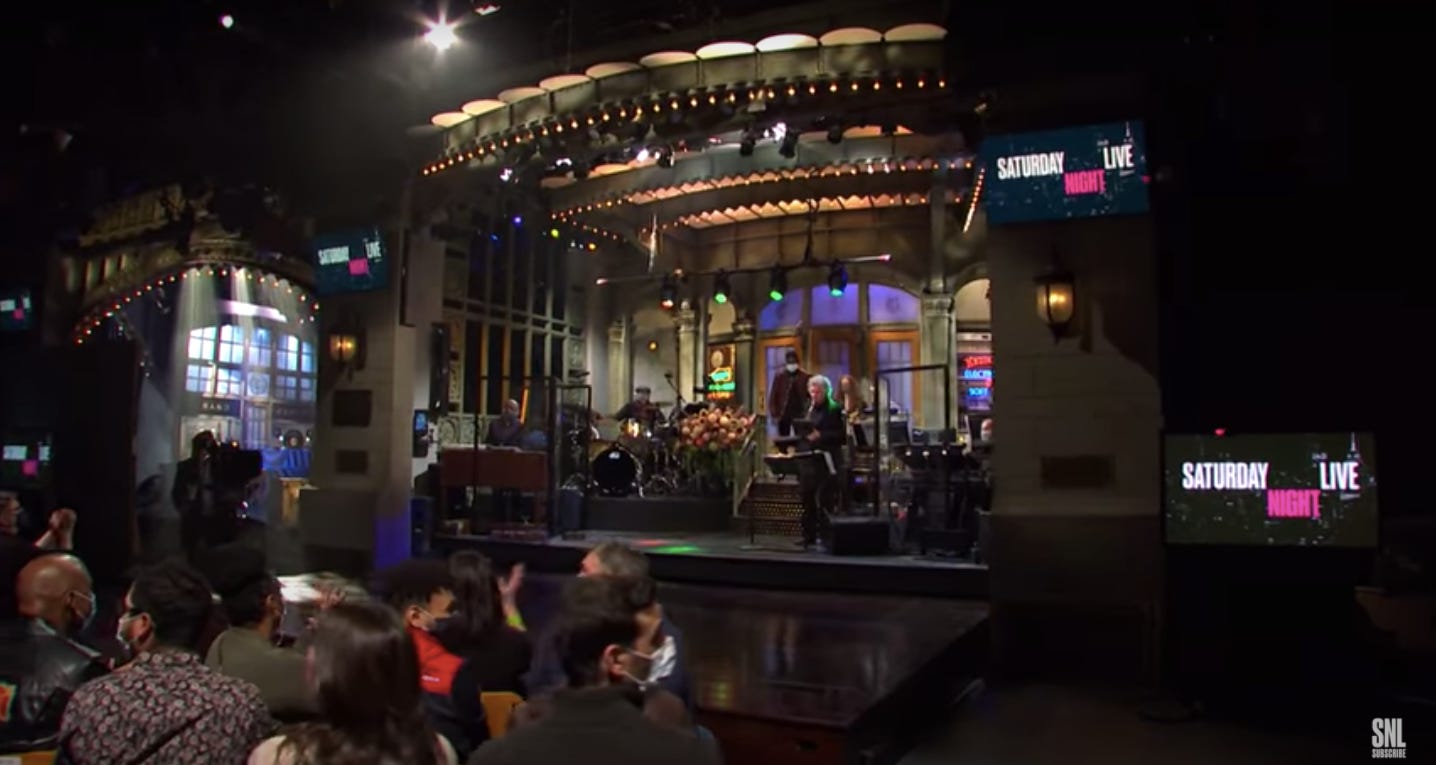
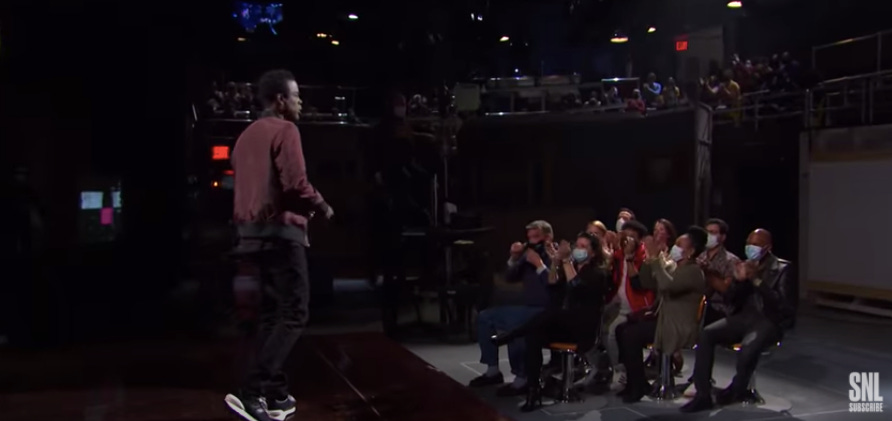
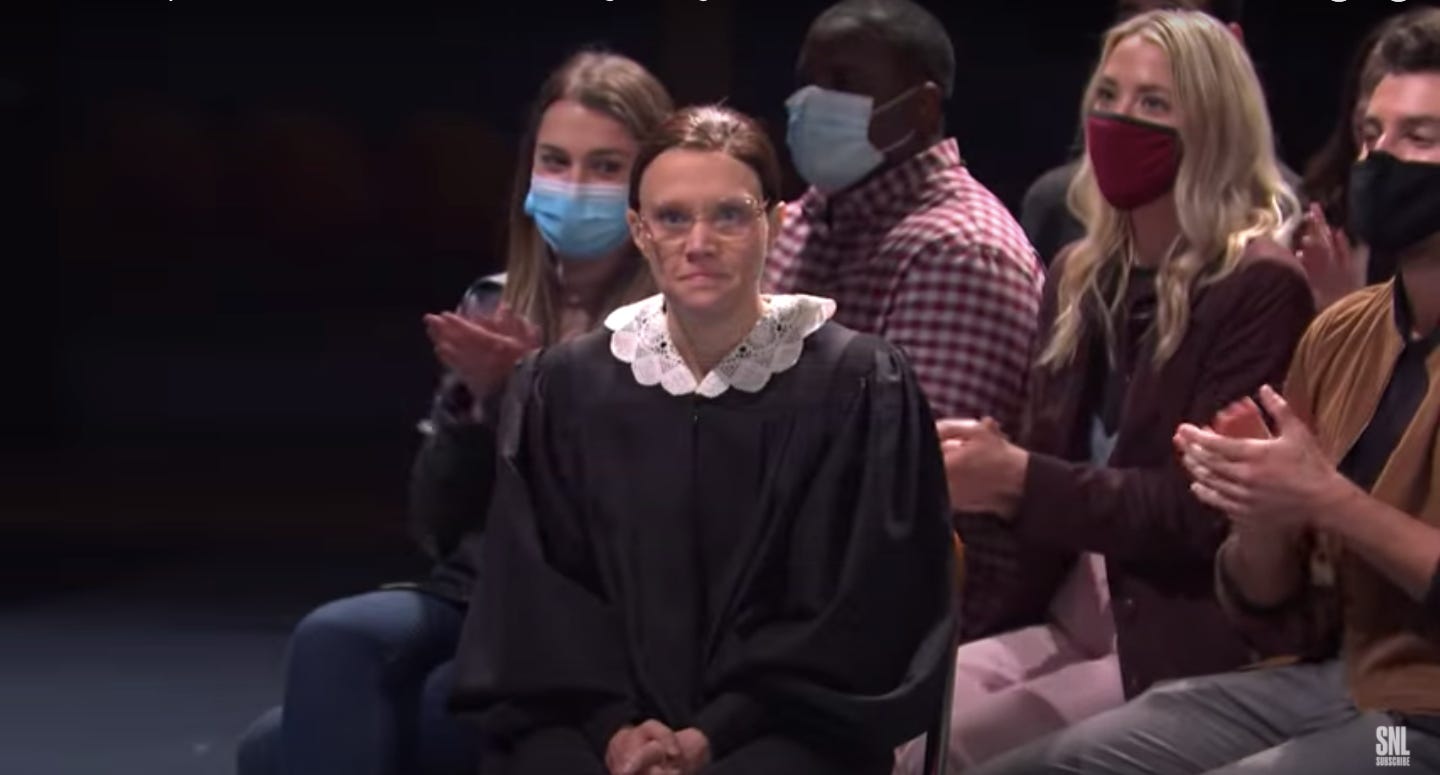
As you can see, these audience members are sitting shoulder-to-shoulder, not six feet apart. Some are sitting very close to SNL’s performers, who took off their masks before going onstage (or into the audience). How can this be safe? Does it even meet the state’s distancing requirement? The answers—whether you find them compelling or not—lie in SNL’s broader approach to audience safety.
One attendee at Saturday’s performance, New York-based product manager Mady Villavicencio, explained that audience members were seated with the 2-, 7-, or 8-person “pods” with whom they applied for tickets. (NBC’s third-party ticketing service referred to them as “social bubbles.”) Hers included 7 friends who all live in the same building and are “sort of in our own pod anyway.” SNL’s screening process asked whether they indeed acted as a pod in their daily lives, but ultimately relied on their good faith. “There’s probably a way to game that system,” Villavicencio said. “There’s a level of trust.”
Villavicencio’s pod travelled by Uber to Rockefeller Center, where she and her friends were directed by NBC pages into their own section of the building’s lobby, far from other pods. “We were instructed that basically until we were all tested and all of us were negative, we couldn't really wander very far,” she told me. "Pages had face masks on and they had these face shields on, and all of them were running around."
Attendees were summoned pod by pod into a separate room, where they self-administered rapid antigen tests. “They had large table with Plexiglas in between us and a bunch of testers from CVS,” Villavicencio said. “They walked us through the directions one by one, and they made sure that we were inserting swabs in our nose, and they basically were saying, ‘Okay, go a little bit deeper.’” She returned to the lobby to await results; if one person in her pod tested positive, they’d all have to go home. Fortunately she and her friends passed, and were allowed to pass through “airport-style security” into a separate area. There they waited on a set of couches—again, far from other pods—until they took their own elevator up to the studio.
“The way that the studio was set up was they had clusters for each pod,” Villavicencio said, with seats between the clusters removed. NBC staffed worked carefully to maintain distance between the pods, at one point directing hers to stand up and move to the back of the studio so another could pass. She estimated that between the orchestra and mezzanine, there were probably about 100 total audience members, all of them wearing masks the whole time.
When the show ended, pods were directed out of the studio one by one. Villavicencio said the process took a while, but it ended with a pleasant surprise: a check, notated with a vendor number, for $150. She has “no idea” whether she owes taxes on it.
Okay, so that’s how being a Pandemic SNL audience member works: you and up to seven people you (purportedly) live or work with go to 30 Rock, get tested, and sit together in your own little section. You don’t distance from your own pod, even though there’s plenty of space for it, because theoretically you’ve all been quarantining anyway.
When I asked Jonah Bruno, the Health Department spokesperson, whether this meets the state’s distancing requirement, he told me what he told the Times: “SNL has confirmed that they followed the reopening guidance, including selecting audience members through a third-party screening and casting process and compensating them for their time as paid audience members. There is no evidence of non-compliance—but if any is discovered, we will refer that to local authorities for follow up.”
When I pressed Bruno about the rule’s requirement that audiences maintain six feet of distance in all directions, he repeated: “There is no evidence of non-compliance—but if any is discovered, we will refer that to local authorities for follow up.” New York City’s health department hasn’t gotten back to me, and an SNL spokesperson told me in a statement that the show has “observed all safety protocols throughout their return to the studio.” In the absence of any official answers, I turned to Lisa M. Lee, a public health expert specializing in infectious disease epidemiology at Virginia Tech, to find out how safe SNL’s protocols really are.
The gist: “We do not yet have an effective vaccine or treatment, so gatherings that are non-essential will continue to put people at risk for COVID-19 and death,” Lee told me in an email. “There are things we can do to make essential gatherings as safe as possible, but we should carefully consider any non-essential gathering.”
Rapid antigen tests, like those used by SNL, are not a failsafe, Lee said. In fact, they yield more false negatives than tests that look for the novel coronavirus’s genetic material. “This means that [people] test negative and are let into an event, but are actually contagious. How much this happens depends on the test and how much virus is circulating in the population, but the consequences are the same—people who are infectious end up with a negative test, which could lead to further spread.”
Lee also expressed caution about SNL’s seating arrangements. “Sitting in pods—that is, members of your household who you know are not infectious—is safer than sitting near people you don’t know, but being in a closed room for 90 minutes with people outside of one’s ‘pandemic pod’ is less of a good idea,” she said. While it’s possible to mitigate the risks of indoor gatherings with universal masking, circulating outside air, and high efficiency air filtration, Lee cautioned that these do not make such gatherings risk-free. (SNL declined to comment on record about the studio’s air filtration. I reached out to the company that owns Rockefeller Center, Tishman Speyer, and will update this post if it responds.)
I asked Lee if she would go to an SNL taping herself. “As much as I would love to go to a taping, I would not at this time,” she replied. “I have made a commitment to my pandemic pod that I will do everything I can to stay uninfected and not put them at risk, so a gathering would need to be essential—and outdoors for me to attend.”
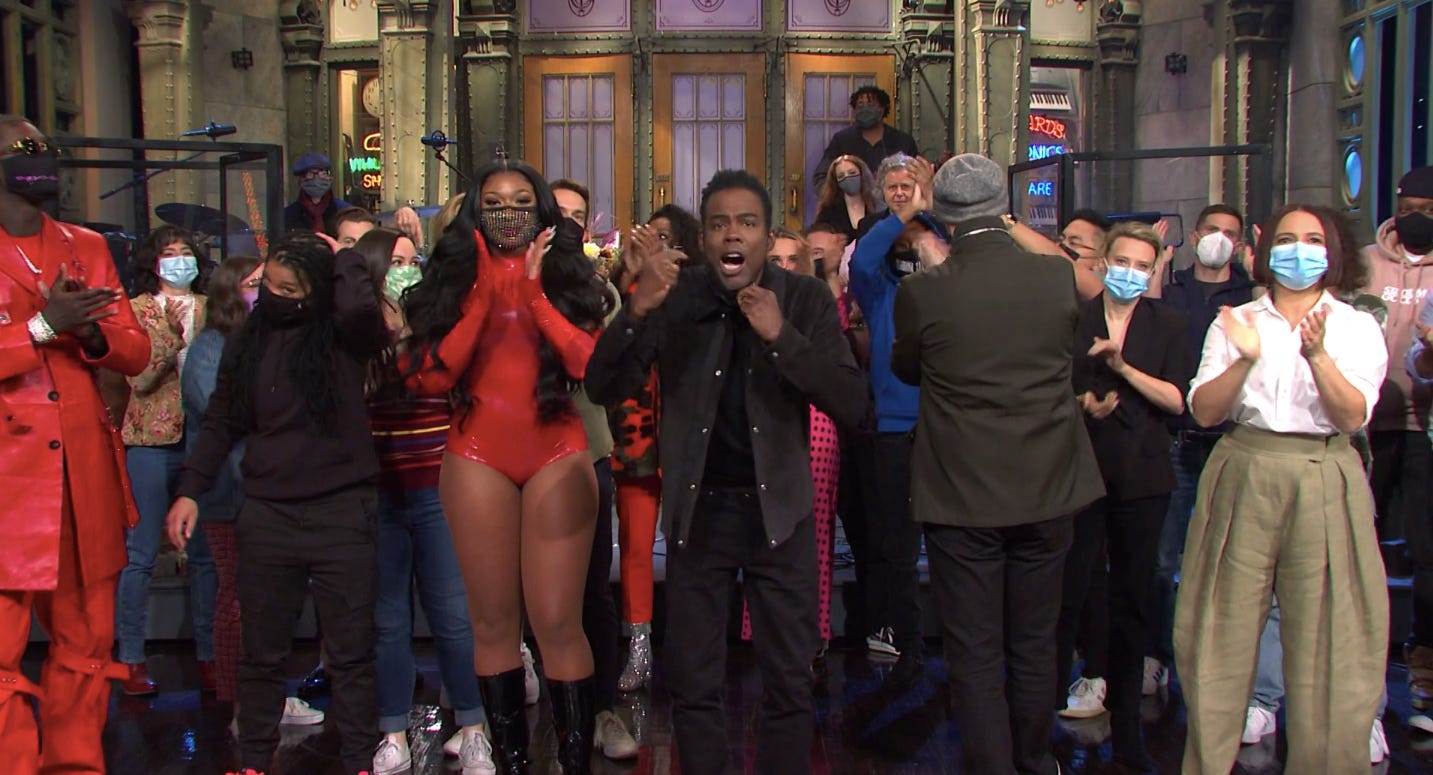
Mady Villavicencio told me she felt safe at the taping. So did Freddy Cruz, another audience member I communicated with over email, who went with his roommate. So will the hundreds of others who attend subsequent episodes, either comfortable with or naive to the risks at every step of the process: from the car to 30 Rock (driven by someone outside their pod), to the rapid tests in its lobby (notorious for their false negatives), to the studio full of strangers laughing and cheering for 90 minutes at unmasked performers (who may themselves have flouted distancing guidelines).
At the heart of SNL’s return is a question of trust. Two questions, really. SNL is asking its audiences to trust their lives to a show that exploited a loophole in New York’s public health guidance for the sake of sketch comedy, while apparently still violating another part of that guidance. And SNL’s audiences are asking everyone else in their lives to trust them in turn.
None of this, as Lee said, is essential. SNL doesn’t need a live audience. Other late night shows get by without one. The difference here is that one man needs an audience to tell him which jokes are funny. “It’s really important to get it right,” Lorne Michaels told Vulture last month. “And laughs are the clear indicator. That’s why the audience is so important. Because you just can’t come out and express your political opinions. There has to be something, something that gets close to the truth that you’re doing and that’s honest. And that’s where the laughs come from.”
Would you trust him?

